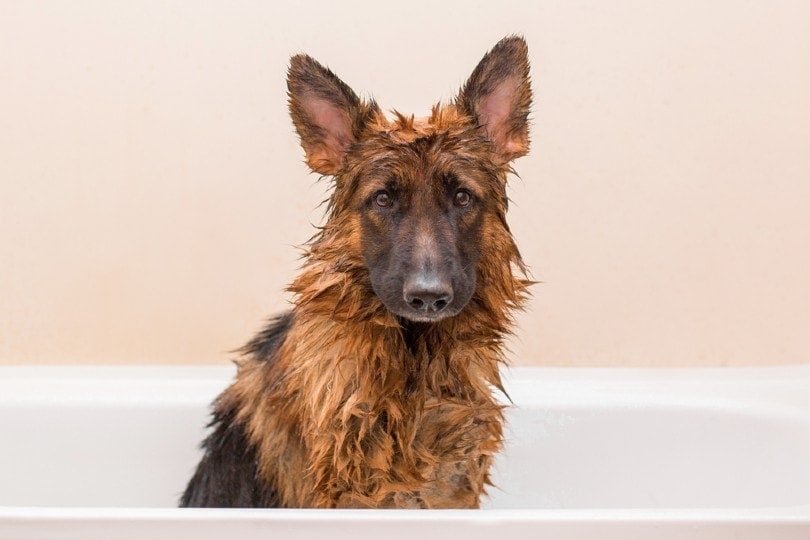
Every dog owner knows that bath time is not a favorite among all canines, but sometimes giving them one is necessary. From running and hiding to whining and shaking, it’s apparent that some dogs have a phobia of getting baths; even water-loving dogs may hate it. So, why do dogs hate baths so much? There are a few reasons, so read on to learn what you can do to help the process go smoothly and make it stress-free for you both, along with the five possible reasons your dog hates baths in the first place.
The 5 Possible Reasons Why Dogs Hate Baths
1. It Brings Back a Scary Memory
For some dogs, a past negative experience will not be easily forgotten, and this can be especially true for older or senior dogs who have recently been adopted. Fear and anxiety could come rushing in if your dog had a traumatic experience with baths, like the water being too hot, slipping in the tub, or a rough former owner who forced baths. It only takes one bad experience to cause an issue. Even a bad experience from a professional groomer can spark fear and anxiety, such as a bad nail trim.
Image Credit: Imfoto,Shutterstock
2. They Hate the Noise
As mentioned, most dogs fear the sound of running water from a faucet or showerhead. Dogs have sensitive hearing, and the sound or running water right by their ears may be traumatic, especially if your dog doesn’t get bathed often. Most dogs only need baths once a month or so unless they get dirty, which means they do not get the opportunity to become desensitized to such sounds.
3. They Have No Control
Dogs want to feel like they are in control, and they greatly dislike being at the mercy of someone else, which is what bath time is all about. Even professional groomers restrain dogs during bath time for their safety and the dogs’ safety. You have control during bath time, which your dog will likely not fancy. This lack of control can scare dogs and cause fear during baths.
Image Credit: Dragon Images, Shutterstock
4. It’s Unfamiliar Territory
If your dog has never had a bath, the experience can be scary because it’s unfamiliar territory. The situation may seem unsafe to your dog, leading to anxiety. It’s vital to acclimate your dog to the bathroom and tub before attempting to give a bath if your dog has never experienced one. The goal here is to make your dog realize that bath time is safe and there’s no need to worry.
5. You Make Bath Time Stressful
Remember that dogs pick up on your emotions, and if you make bath time stressful, your dog will associate bath time as a stressful event; it’s as simple as that. You must avoid rough handling, forcing the issue, yelling, or any other negative act, as this is not good for your pooch. Talk with a soothing voice, don’t force it, and use slow movements throughout the entire process. If you’re stressed at the time, avoid bathing your dog until you are more relaxed.
Image Credit: Roman Chazov, Shutterstock
5 Tips for Bathing a Dog
Before You Start
The last thing you want is to stress out your dog before the bath, which will only make matters worse. Your goal is to teach your dog that baths are not all that horrible. In other words, you want to make the entire experience positive.
Even a water-loving dog, such as the Labrador Retriever, may turn up their nose at a bath, leaving you to speculate that it’s not the water your dog is afraid of, per se. When water-loving dogs go swimming, they are in control, whereas when a human baths them, they have no control over the situation, leading to fear and anxiety.
Each dog will have their own reaction to baths, and some may have more fear than others. It’ll be up to you to determine your dog’s fear level and act accordingly. Nonetheless, here are a few pointers before you start bath time.
Image Credit: Ihar Halavach, Shutterstock
1. Provide Treats
Most dogs love peanut butter (ensure the peanut butter is free from xylitol, which is toxic to dogs), and peanut butter can come in handy while bathing your dog. Smear peanut butter on the wall so your dog can focus on that rather than the bath.
You can also provide treats when guiding your dog to the bathroom. This step is a process and may take some time, but be patient. You never want to force your dog, as this could traumatize them and will always produce a negative experience for your pooch. Start slowly and give treats when your dog enters the bathroom and approaches the tub or shower. The goal is to condition your dog for everything the bath entails, including the bathtub and the area it’s in.
You can try placing your dog in a dry bathtub and rewarding them afterward. You can then slowly work up to water, but never forget treats and praise.
2. Avoid the Faucet and Showerhead
Some dogs dislike the sound of running water coming from the faucet or showerhead. Before taking your dog into the bathroom, fill the tub with warm (not hot or cold!) water. Go ahead and fill a bucket or two with water for rinsing while you’re at it.
Image Credit: Irina Kozorog, Shutterstock
3. Make It a Family Affair
If your dog seems more comforted with the whole family present for the dreaded bath, by all means, rally in the troops for support. You may be surprised at the calming effect this can have on your pooch.
4. Stay Calm
If you get stressed, your dog will sense it, which will also make them stressed before you even begin. Use soft, soothing tones, and avoid sudden movements. Remember that you’re trying to create a positive, stress-free environment for the task at hand.
Image Credit: 220 Selfmade studio, Shutterstock
5. Place a Rubber Mat in the Tub
Some dogs may have had a bad experience from slipping in the tub during bath time. Dogs like to have control, and fear will set in if they slip. Placing a rubber mat will prevent your dog from slipping and provide a more positive experience.
Conclusion
Most dogs hate baths, but they still need one from time to time. However, the ultimate goal is to make the experience positive for your dog to avoid stress. Implementing the above steps before you start can help ease fear and anxiety, creating a more positive outcome. Remember that bath time doesn’t always have to be a dreaded event; it just takes patience, repetition, rewards, and praise to get your dog acclimated. It may take some time, but don’t give up!
Featured Image Credit: Korneeva Kristina, Shutterstock






